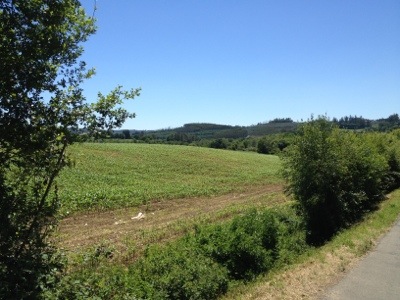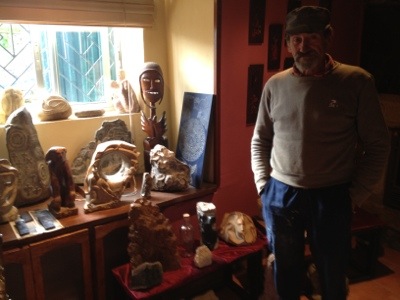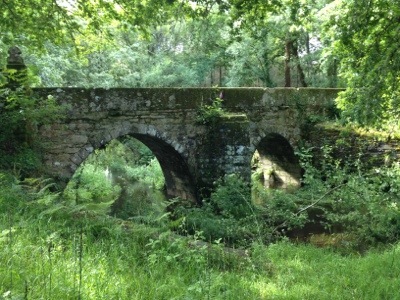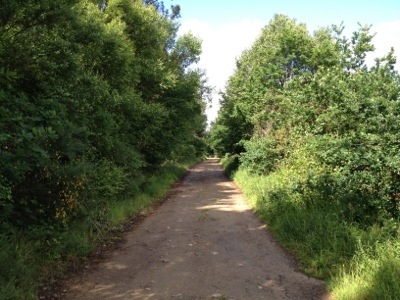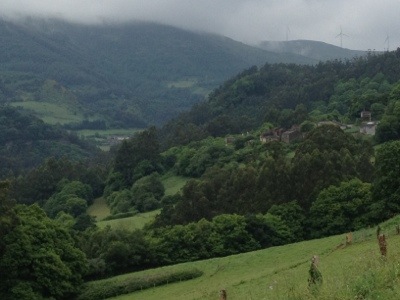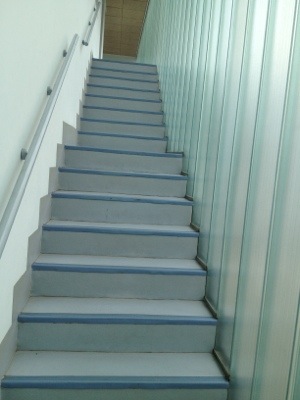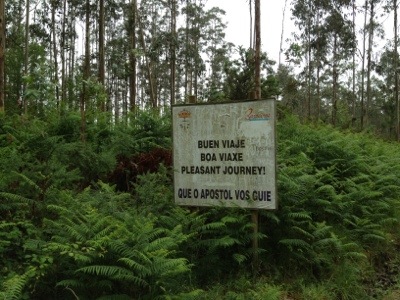
Twenty-eight days in Northern Spain from Bilbao (right) to Santiago (left). Click to see detailed Google Map.
My eyes tear up even as I write these words, and I have to stop and dry them before I can continue. Santiago is always an emotional experience for me. Four times now I have sat in the cathedral a few blocks from here and one by one thanked God for the blessing of each individual camino friend. I know that people walk the Camino de Santiago for mystical reasons or for exercise or to enjoy Spanish culture. It’s clear to me that I walk the camino to enjoy the pilgrims themselves. In well over 100 days of walking since the start of my first camino in 2008 it is the faces and memories of pilgrims that stand out most in my mind. The close ties of friendship and affection that form with camino friends are, to me, the very presence of God.I have appreciated the thoughts and prayers of past pilgrim friends, friends and family from home and also of other pilgrims and soon-to-be pilgrims whom I’ve never met but who’ve communicated their support on this site and elsewhere.
Many have asked how I’ve held up. Other than being a little weepy, which is expected in the last days of a pilgrimage, I’m fine. My feet and legs are still sore from yesterday’s 40 km walk. I have a head cold that I’ll try to keep from moving to my chest. I’ve lost 14 pounds (6.5 kilos) and my face is pinkish brown from sun and wind. My arms and legs are deeply tanned, my skin is a little too dry, my hair is begging to be trimmed, and I have a smile on my face.
Some details of the walk, in no particular order: By the numbers, I walked 677 km in twenty-seven days of actual walking. I took two actual rest days.
I stayed in albergues, mostly, but also in a couple of pensiones and a couple of 4-star hotels in some of the big cities.
I did take the train once, for a three minute ride across a river that otherwise would have added 11 km to my total. The three minute ride, due to my own mistake, ended up adding about two hours to my day — roughly the time it would’ve taken to walk the 11km. I took boats twice, also to cross rivers, and loved every second on the water.
I met pilgrims from at least these nations: Poland, Czech Republic, Estonia, Hungary, Denmark, Netherlands, Germany, Austria, UK, Scotland, France, Italy, Switzerland, Ireland, Spain, Canada and the USA.
I posted every single day on my blog, for which AT&T reaped a rich ransom through its International Data Plan, and since I began the walk my blog has received over 10,000 hits. Blogging this camino was an exercise in self-discipline that became a welcome time of daily reflection. I hope it will be a helpful resource for future pilgrims considering the Camino del Norte. All blog posts and all photographs were created on my iPhone 4Gs and posted through the WordPress iPhone app (thanks, Sophia).
Though my Spanish is still rudimentary I am getting better at listening and understanding, as well as expressing myself. I need to go back to my college textbooks and bone up on verb tenses and vocabulary. After that, with more practice, I could become a decent Spanish speaker.
My actual itinerary was:
- May 28 Arrived Bilbao, met by Sebastian, overnight at hotel
- May 29 Portugalete (walked with Sebastian, stayed at pension)
- May 30 (Pobena) Castro Urdiales
- May 31 Laredo (beach town albergue with 2 English kids)
- June 1 Guemes (Don Ernesto’s albergue)
- June 2 (Galizano, Loredo, Somo) Santander
- June 3 Boo (goodbye to Sebastian; Santander overnight)
- June 4 (Mogro, Mar) Santillana del Mar
- June 5 Comillas (argue with hospitalero boss)
- June 6 Colombres (Mad Men motel)
- June 7 Llanes (TV tower, pink hotel)
- June 8 Ribadesella (goodbye to Spanish 5)
- June 9 Sebrayo (remote albergue with food truck)
- June 10 Deba (Gijon – albergue in campground with swimming pool)
- June 11 Gijon (rest day)
- June 12 Gijon (rest day, Martin arrives)
- June 13 Aviles (factories)
- June 14 Cordillero (left Martin)
- June 15 Cadavedo (met Michael, Stefan; hotel with Julian)
- June 16 Luarca (Martin awaits)
- June 17 La Caridad (explosives, ritzy hotel with antiques; chicken/fries dinner)
- June 18 (Tapia, German, giant bridge) Ribadeo
- June 19 Lourenza (big church, with Julian for dinner)
- June 20 Gontan (albergue, Methodists)
- June 21 Vilalba (tall, black albergue by fire station)
- June 22 (Baamonde) Deva (vegetarian albergue)
- June 23 Deva to Sebrado dos Monxes (met up with Martin and Jacqueline)
- June 24 Sebrado to Arzua (walked with Martin, Jacqueline and Carina)
- June 25 Arzua to Santiago (40 km in blazing sun)
I’ve now walked approximately 2,700 kilometers (1,687 miles) on four camino paths (Camino Frances, Via de la Plata, Camino Finisterre, Camino del Norte) since 2008, and yes, I’m brainstorming now with pilgrim friends about the when and where of the next walk.
My only real regret about this year’s walk is that I did not throw off my pack and most of my clothes when I had the chance and swim at one of the many beautiful beaches I passed along the way. The other regret I have is always the same on every camino: I deeply miss Gail, my family, my home, my church and my friends. As much as I love the camino, I’m ready to return to summer in Seattle.
Thanks for faithfully reading along as I’ve described and reflected on this adventure. Thanks for your support and encouragement which helped motivate me to write. These reflections were composed in albergue bunks, on tables in outdoor cafes and bars, sometimes outside on cold steps or benches, but nearly always between ten and midnight after other pilgrims were fast asleep. I’m sure some thought it odd that I often had my nose in my cellphone until late into the night, but your encouragement meant that writing was never a burden, always a blessing.
Here are a few photos from the trip that I haven’t yet posted but are of sights I enjoyed:
 Santiago (St. James) a dear friend and fellow pilgrim. In Bilbao at the start of the walk and with me each step of the way.
Santiago (St. James) a dear friend and fellow pilgrim. In Bilbao at the start of the walk and with me each step of the way.
 This is my first photo of Jon of Calgary (in red), seen at the Castro Urdiales albergue, showing he was there almost from my start. I’ll meet him for lunch here in Santiago in about an hour.
This is my first photo of Jon of Calgary (in red), seen at the Castro Urdiales albergue, showing he was there almost from my start. I’ll meet him for lunch here in Santiago in about an hour.
 Two burros whose photo I share to represent all the livestock and other animals I passed along the way — burros, horses, cows, goats, sheep, dogs, cats, deer, hawks, fish, snakes, lizards, an eel, and one road kill badger.
Two burros whose photo I share to represent all the livestock and other animals I passed along the way — burros, horses, cows, goats, sheep, dogs, cats, deer, hawks, fish, snakes, lizards, an eel, and one road kill badger.
 This sign also says “turn left” but only because it’s in Galicia, not Asturias.
This sign also says “turn left” but only because it’s in Galicia, not Asturias.
 Local kids at Luarca partying with way too much beer. They laughed hard that a tourist/pilgrim would take a photo of them.
Local kids at Luarca partying with way too much beer. They laughed hard that a tourist/pilgrim would take a photo of them.
 Kitchen of the Aviles albergue. No, I’m not kidding.
Kitchen of the Aviles albergue. No, I’m not kidding.
 Proud Elena of Cafe Roxica with her homemade cheese.
Proud Elena of Cafe Roxica with her homemade cheese.
 And to all dogs of all caminos, doing their work of keeping their packs safe.
And to all dogs of all caminos, doing their work of keeping their packs safe.









